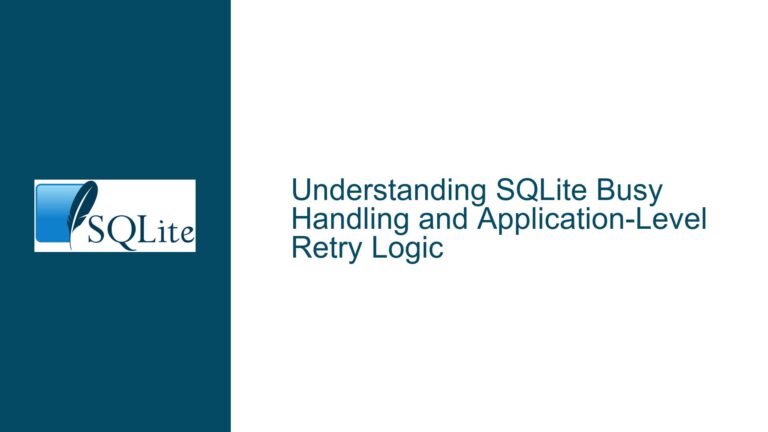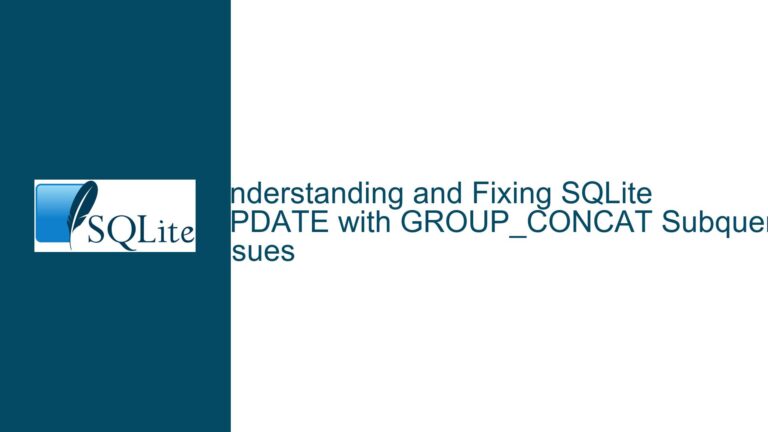Ensuring Atomic Read-Delete Operations in SQLite to Prevent Concurrent Access Conflicts
Concurrency Risks in Read-Delete Workflows and Transactional Isolation
Issue Overview
The challenge of atomically retrieving and deleting a record in SQLite arises when multiple database connections or processes operate concurrently. A naive implementation involving separate SELECT and DELETE statements creates a race condition: Process A reads a record, but before it deletes it, Process B reads the same record. Both processes then act on the same data, violating atomicity. This becomes critical in scenarios like job queues, inventory management, or distributed systems where exclusive access to data is mandatory. The problem intensifies in high-concurrency environments where milliseconds matter, and stale data reads lead to duplicated processing, data corruption, or logical inconsistencies.
SQLite’s default auto-commit mode exacerbates this: Each statement executes in its own transaction, releasing locks immediately. Without explicit transaction control, the window between SELECT and DELETE allows other connections to read or modify the data. The core requirement is to establish an isolation boundary where the read-delete operation appears instantaneous to other processes, enforced through locking mechanisms. This demands a deep understanding of SQLite’s transactional model, lock escalation rules, and the interplay between isolation levels and the RETURNING clause introduced in v3.35.0.
Mechanisms of Lock Contention and Transactional Scope
1. Implicit vs. Explicit Transactions
In auto-commit mode, SQLite wraps each statement in a transient transaction. A SELECT acquires a SHARED lock, allowing other reads but blocking writes. The lock is released immediately after the statement. A subsequent DELETE initiates a new transaction, requiring a RESERVED lock. Between these two auto-committed transactions, another process could acquire a SHARED lock, observe the same record, and act on it. Explicit transactions eliminate this gap by maintaining a continuous lock throughout the operation.
2. Lock Hierarchy and Compatibility
SQLite uses a tiered locking system: UNLOCKED → SHARED → RESERVED → PENDING → EXCLUSIVE. Concurrent reads are permitted under SHARED locks, but writes require escalating to RESERVED. The BEGIN IMMEDIATE command jumps to RESERVED, preventing other writers but allowing readers. This is critical because a RESERVED lock signals intent to write, blocking other connections from acquiring RESERVED or EXCLUSIVE locks. However, readers in SHARED mode can still see pre-transaction data until the writer commits.
3. Isolation Levels and Phantom Reads
SQLite implements Serializable isolation for transactions, meaning all operations within a transaction see a consistent snapshot. However, without proper locking, a DELETE might not affect rows added after the initial SELECT. This is mitigated by using BEGIN IMMEDIATE to enforce strict ordering: Once a transaction holds a RESERVED lock, subsequent changes by others are invisible until commit.
4. RETURNING Clause and Atomicity
The DELETE ... RETURNING syntax (v3.35.0+) combines retrieval and deletion into a single atomic operation. However, its effectiveness depends on transactional context. Without an explicit transaction, the statement auto-commits, but the moment it executes, the row is marked as deleted. Other processes attempting to read the row after the DELETE starts but before it commits will encounter a BUSY state if the database is in WAL mode, or see the old data in DELETE mode due to SQLite’s file locking.
Implementing Robust Read-Delete Workflows
Step 1: Choosing the Correct Transaction Type
Use BEGIN IMMEDIATE to acquire a RESERVED lock upfront. This prevents other writers and signals intent to modify data. In contrast, BEGIN DEFERRED starts in UNLOCKED state, escalating locks only when needed, which risks deadlocks or race conditions.
Example:
BEGIN IMMEDIATE;
DELETE FROM tasks WHERE id = 123 RETURNING *;
COMMIT;
Step 2: Leveraging RETURNING for Atomic Retrieval and Deletion
Replace separate SELECT and DELETE with a single statement. This reduces the time the lock is held and eliminates the gap between operations.
Example for Job Queue Processing:
BEGIN IMMEDIATE;
DELETE FROM job_queue
WHERE status = 'pending'
ORDER BY created_at ASC
LIMIT 1
RETURNING id, payload;
COMMIT;
Step 3: Handling Empty Results and Contention**
Check if the DELETE ... RETURNING yielded a result. If not, the record was already processed by another connection. Use a loop with exponential backoff to retry, avoiding busy-waiting.
Pseudocode Implementation:
import sqlite3
import time
def fetch_and_delete():
retry_delay = 0.1
max_retries = 5
for _ in range(max_retries):
conn = sqlite3.connect('jobs.db', isolation_level=None)
cursor = conn.cursor()
try:
cursor.execute('BEGIN IMMEDIATE')
cursor.execute('''
DELETE FROM job_queue
WHERE queue_name = 'default'
RETURNING id, payload
''')
row = cursor.fetchone()
conn.commit()
return row
except sqlite3.OperationalError as e:
if 'database is locked' in str(e):
time.sleep(retry_delay)
retry_delay *= 2
continue
raise
finally:
conn.close()
return None
Step 4: Schema and Index Optimization**
Ensure the WHERE clause in DELETE ... RETURNING uses indexed columns. Without an index on yummy in the original example (dickiedee table), SQLite scans the entire table, holding locks longer and increasing contention.
Index Creation:
CREATE INDEX idx_dickiedee_yummy ON dickiedee(yummy);
Step 5: WAL Mode and Connection Pooling**
Enable Write-Ahead Logging (WAL) for concurrent reads and writes. In WAL mode, readers don’t block writers and vice versa, but BEGIN IMMEDIATE still serializes write transactions. Use a connection pool with a single writer and multiple readers to balance throughput.
Enabling WAL:
PRAGMA journal_mode=WAL;
Step 6: Testing with Concurrent Workloads**
Simulate high concurrency using parallel threads or processes. Measure the frequency of duplicate processing or missed deletions. Tools like sqlite3’s .repeat command or Python’s threading module can stress-test the logic.
Concurrency Test Script:
import threading
import sqlite3
def worker():
conn = sqlite3.connect('test.db', isolation_level=None)
cursor = conn.cursor()
cursor.execute('BEGIN IMMEDIATE')
cursor.execute('DELETE FROM data WHERE id=1 RETURNING value')
result = cursor.fetchone()
conn.commit()
conn.close()
print(f'Worker {threading.get_ident()} got: {result}')
# Initialize test data
conn = sqlite3.connect('test.db')
conn.execute('CREATE TABLE IF NOT EXISTS data (id INTEGER PRIMARY KEY, value TEXT)')
conn.execute('INSERT INTO data (id, value) VALUES (1, "test")')
conn.commit()
conn.close()
# Spawn 10 threads
threads = []
for _ in range(10):
t = threading.Thread(target=worker)
threads.append(t)
t.start()
for t in threads:
t.join()
Step 7: Analyzing Lock Timeouts and Deadlocks**
Configure busy_timeout to handle locked databases gracefully. SQLite’s default behavior is to immediately return SQLITE_BUSY, but a timeout allows retries.
Setting Busy Timeout:
conn = sqlite3.connect('test.db', timeout=5) # 5-second busy timeout
Step 8: Transaction Rollback and Error Handling**
Wrap transactions in try-except blocks to handle exceptions and avoid leaving open transactions, which can cause deadlocks. Always rollback on errors.
Error Handling Example:
conn = sqlite3.connect('data.db')
try:
conn.execute('BEGIN IMMEDIATE')
conn.execute('DELETE FROM records WHERE id=42 RETURNING *')
conn.commit()
except sqlite3.DatabaseError as e:
conn.rollback()
print(f'Transaction failed: {e}')
finally:
conn.close()
Step 9: Monitoring and Diagnostics**
Use SQLite’s sqlite3_trace or PRAGMA lock_status (in DEBUG builds) to monitor lock acquisition. Logging transaction durations helps identify bottlenecks.
Enabling Trace in Python:
def trace_callback(statement):
print(f'Executing: {statement}')
conn = sqlite3.connect('test.db')
conn.set_trace_callback(trace_callback)
Step 10: Version Compatibility Checks**
Verify SQLite’s version supports RETURNING (≥3.35.0). Use sqlite3.sqlite_version to check and fall back to SELECT; DELETE if necessary.
Version Check:
import sqlite3
print(sqlite3.sqlite_version) # Must be >= '3.35.0'
Final Considerations
The combination of BEGIN IMMEDIATE and DELETE ... RETURNING provides a robust solution for atomic read-delete operations. However, in highly contentious environments, consider alternative architectures like message queues with at-least-once delivery guarantees or application-level leases. SQLite’s simplicity and ACID compliance make it suitable for embedded systems and moderate concurrency, but extreme workloads may require distributed systems techniques beyond single-node databases. Always validate through load testing and implement monitoring to catch regressions.






